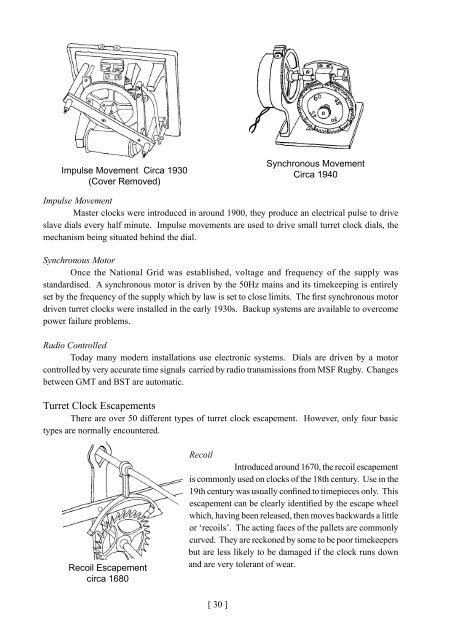You also want an ePaper? Increase the reach of your titles
YUMPU automatically turns print PDFs into web optimized ePapers that Google loves.
Impulse Movement Circa 1930<br />
(Cover Removed)<br />
Synchronous Movement<br />
Circa 1940<br />
Impulse Movement<br />
Master clocks were introduced in around 1900, they produce an electrical pulse to drive<br />
slave dials every half minute. Impulse movements are used to drive small turret clock dials, the<br />
mechanism being situated behind the dial.<br />
Synchronous Motor<br />
Once the National Grid was established, voltage and frequency of the supply was<br />
standardised. A synchronous motor is driven by the 50Hz mains and its timekeeping is entirely<br />
set by the frequency of the supply which by law is set to close limits. The first synchronous motor<br />
driven turret clocks were installed in the early 1930s. Backup systems are available to overcome<br />
power failure problems.<br />
Radio Controlled<br />
Today many modern installations use electronic systems. Dials are driven by a motor<br />
controlled by very accurate time signals carried by radio transmissions from MSF Rugby. Changes<br />
between GMT and BST are automatic.<br />
<strong>Turret</strong> <strong>Clock</strong> Escapements<br />
There are over 50 different types of turret clock escapement. However, only four basic<br />
types are normally encountered.<br />
Recoil Escapement<br />
circa 1680<br />
Recoil<br />
Introduced around 1670, the recoil escapement<br />
is commonly used on clocks of the 18th century. Use in the<br />
19th century was usually confined to timepieces only. This<br />
escapement can be clearly identified by the escape wheel<br />
which, having been released, then moves backwards a little<br />
or ‘recoils’. The acting faces of the pallets are commonly<br />
curved. They are reckoned by some to be poor timekeepers<br />
but are less likely to be damaged if the clock runs down<br />
and are very tolerant of wear.<br />
[ 30 ]

















